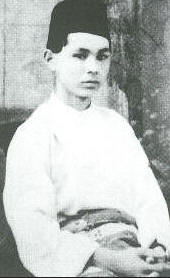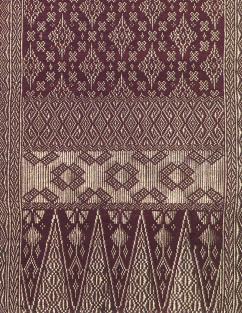 W
WBaju Kurung is a traditional costume originated from Sumatra, and Malay peninsula, and is traditionally worn by women in Brunei, Indonesia, Malaysia, Singapore and southern Thailand. This type of traditional costume is the national dress of Brunei and Malaysia. In Indonesia, it is also one of the regional dresses, seen most on the island of Sumatra, where many ethnic Malay and Minangkabau women wear it.
 W
WBaju Melayu is a traditional Malay costume, originated from the court of Malacca, and is traditionally worn by men in Brunei, Malaysia, Singapore, parts of Indonesia, southern Philippines, and southern Thailand. It literally translates as Malay dress and consists of two main parts. The first being the baju itself which has a raised stiff collar known as the cekak musang collar. The second part is the trousers called seluar. The two parts are made out of the same type of fabric which is usually cotton, or a mixture of polyester and cotton. A skirt-type adornment is also commonly worn with the Baju Melayu, which is either the kain samping, made out of songket, tenun cloth or the kain sarung, made out of cotton or a polyester mix. Both are loops of fabric that are folded around the wearer's waist. A jet-black or dark-colored headgear called the songkok can also worn to complete the attire.
 W
WBatik is an Indonesian technique of wax-resist dyeing applied to the whole cloth. This technique originated from the island of Java, Indonesia. Batik is made either by drawing dots and lines of the resist with a spouted tool called a canting, or by printing the resist with a copper stamp called a cap. The applied wax resists dyes and therefore allows the artisan to colour selectively by soaking the cloth in one colour, removing the wax with boiling water, and repeating if multiple colours are desired.
 W
WA blangkon or belangkon is a traditional Javanese headgear worn by men and made of batik fabric. There are four types of blangkons, distinguished by the shapes and regional Javanese origin: Ngayogyakarta, Surakarta, Kedu, and Banyumasan.
 W
WBodo blouse or locally known as Baju Bodo, is a sheer and transparent short sleeved loose blouse, a traditional costume for women of Bugis and Makassar tribes of South Sulawesi, Indonesia. Bodo blouse is traditionally combined with a matching woven sarong that covered the waist below the body.
 W
WA kebaya is an upper garment traditionally worn by women in Southeast Asia, notably in Brunei, Indonesia, Malaysia, and Singapore. Outside of Southeast Asia, it is worn by Javanese, Malays and Portuguese Eurasians in Australian Cocos Islands and Christmas Island, coastal India and Sri Lanka, Macau as well as South Africa. The complete outfit is known as "sarong kebaya".
 W
WKemben is an Indonesian female torso wrap historically common in Java and Bali. It is made by wrapping a piece of kain (clothes), either plain, batik printed, velvet, or any type of fabrics, covering the chest wrapped around the woman's torso.
 W
WA sarong or sarung ; is a large tube or length of fabric, often wrapped around the waist, worn in Southeast Asia, Southern Asia, Western Asia, Northern Africa, East Africa, and on many Pacific islands. The fabric often has woven plaid or checkered patterns, or may be brightly colored by means of batik or ikat dyeing. Many modern sarongs have printed designs, often depicting animals or plants. Different types of sarongs are worn in different places in the world, notably, the lungi in the Indian subcontinent and the izaar in the Arabian Peninsula.
 W
WSongket is a fabric that belongs to the brocade family of textiles of the Malay world (today, Brunei, Indonesia, Malaysia and Singapore. It is hand-woven in silk or cotton, and intricately patterned with gold or silver threads. The metallic threads stand out against the background cloth to create a shimmering effect. In the weaving process the metallic threads are inserted in between the silk or cotton weft threads in a technique called supplementary weft weaving technique.
 W
WThe songkok or peci or kopiah is a cap widely worn in Brunei, Indonesia, Malaysia, Singapore, the southern Philippines and southern Thailand, most commonly among Muslim males. It has the shape of a truncated cone, usually made of black or embroidered felt, cotton or velvet. It is also worn by males in formal occasions such as weddings and funerals or festive occasions such as the Eid ul-Fitr and Eid al-Adha holidays. In Indonesia, the peci is also associated with the nationalist movement.
 W
WTapis is a traditional weaving style and also refers to resulting cloth that originated from Lampung, South Sumatra, Indonesia. It consists of a striped, naturally-coloured cloth embroidered with warped and couched gold thread. Traditionally using floral motifs, it has numerous variations. It is generally worn ceremonially, although it can be used as a decoration. It is considered as one of the symbols of Lampung and Lampungese.
 W
WTi'i langga is the wide-brimmed hat found in Rote Island, eastern Indonesia. Rote Island is the southernmost of the inhabited islands of Indonesia, in the island province of East Nusa Tenggara, not far away from Timor. The characteristic feature of the hat is the 40 to 60 centimeter high unicorn-like horn or plume sticking up near the front. Together with the sasando, the ti'i langga is the cultural identity of the culture of Rote island.
 W
WUpuh Ulen-Ulen, also known as kerawang gayo, is a traditional cloth of the Gayonese people in Aceh, Indonesia.